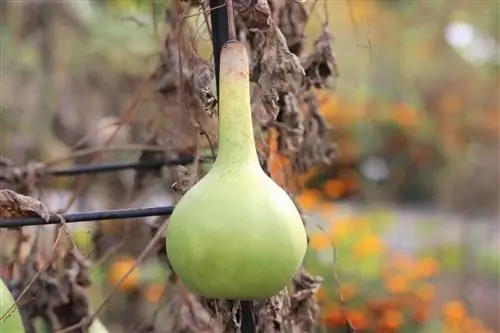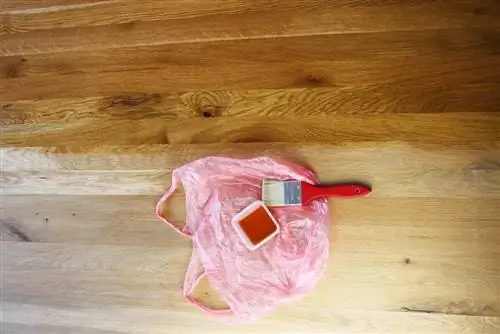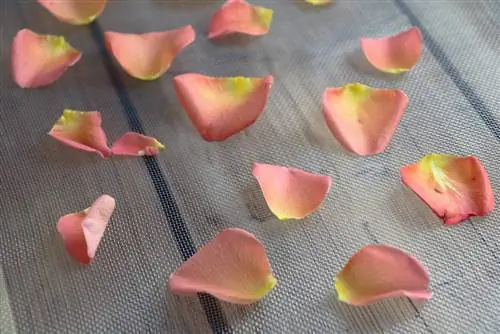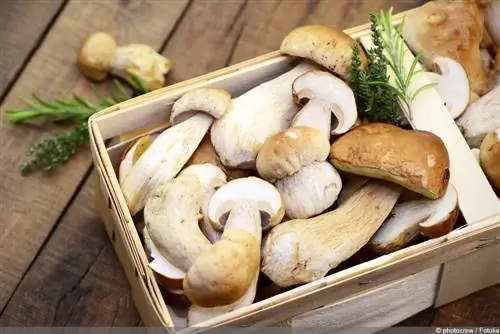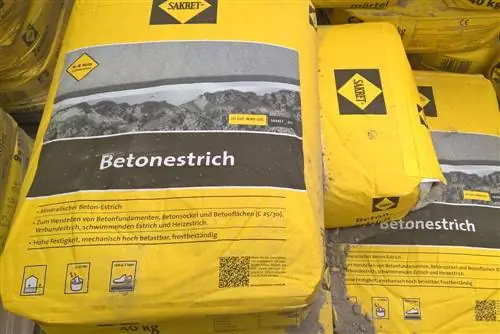- Author admin [email protected].
- Public 2023-12-17 03:39.
- Last modified 2025-01-24 12:45.
Many of us initially associate the bottle gourd, the so-called calabash, with musical instruments or original storage places. In recent years, this unusual pumpkin has also found its way to us. It is easy to cultivate and is always a real eye-catcher with its unusual shapes. Here you can find out more about the correct cultivation and drying process in order to create your own creations with the calabashes you have grown yourself.
Location and soil
The calabash pumpkin is a climbing plant, it needs a sunny location and wants moist soil without waterlogging making life difficult for it. However, it cannot climb itself up, so you have to tie it up at regular intervals. Set up a sturdy trellis, the plants can grow quite tall. You should definitely allow for two meters. A sturdy fence that provides sufficient support for the heavy fruits is well suited. Another option are poles that are anchored crosswise in the ground like climbing beans. It also requires space on the ground, so the plants should not be planted too close together; a planting distance of around 40 cm is recommended.
- Pumpkins need a lot of water, not only in dry periods, ensure there is enough moisture
- water in the evening so the plant can absorb the water overnight
- from mid to late June you can mulch to prevent evaporation in strong sunshine
- do not use wire to tie up, it cuts into the stems and prevents the absorption of water and nutrients
Sowing and care
In order to obtain strong plants, the seeds should be pre-germinated from early to mid-April. The trade offers seeds of different varieties, sometimes with different seeds in one bag. This makes it possible to raise several different calabashes in a variety of shapes and colors. Place one to three seeds of each variety in a planting hole; after germination you should only put the strongest plant in the garden. Planting takes place after the Ice Saints, when night frosts are no longer expected. The bottle gourd is a sun worshiper and loves warm temperatures, but cold can harm it. Due to early germination, the plants grow stronger and the harvest can then take place earlier. The plants should be thinned out in order to obtain fewer, but larger and high quality fruits. The first flowers appear from the end of May to the beginning of June, and then you can literally watch them grow because the fruits develop quite quickly.
the fruits can be quite heavy, under certain circumstances they should be supported additionally
Tip:
Let the pumpkin plants that only develop a small to medium size grow on a pergola, for example, the fruits then hang decoratively from the ceiling. Make sure that heavy specimens also need to be supported here to avoid falling.
Harvesting and drying
Calabash pumpkins should not be harvested too early. It's best to wait until the plant starts to wilt, then the days and nights will start to get cooler. If the fruits are harvested too early, they may begin to rot during drying, making further use impossible. The harvested calabashes are dried in a dry and warm place. Make sure that it is truly air drying; no acceleration should be carried out. A cellar or a quiet place in a garden shed is best. Since not all fruits can stand on their own, it is recommended to either hang them by the neck with a gardener's baste or to place a ring made of sturdy fabric or cardboard underneath. During the drying process, the pulp becomes woody and impermeable to water, so that liquids can also be stored in it after it has completely dried out.
- After drying, the calabash can be processed with a small saw, for example to make a birdhouse
- leave the calabash intact while it is still drying, the pulp inside could rot
- the light, compostable material can also be made into an original lamp, sawing off the base, routing cables through the neck
- The calabash is completely dry when the seeds inside rattle loudly and clearly when shaken
Tip:
The outer skin is easy to paint, creating unique pieces. If you don't want to use paint, use clear varnish to make the specimen shine.
Backgrounds
Calabashes originally come from tropical and subtropical areas, where they were used early on as containers for liquids, musical instruments, rattles or drinking vessels. The variety is astonishing, ranging in size from just 5 cm to almost three meters. The shapes and colors also vary, from light yellow to deep dark green or orange and brown. The snake-like specimens, which do not have a balloon-shaped body, can even be shaped like a spiral when tied over a wooden stick as they grow. It is also possible to deform the classic calabashes by supporting the fruit so that the neck forms an arch. You should do this carefully so as not to damage the shell or break the neck. Calabashes shaped like this are particularly eye-catching decorative items when they are painted like ducks, for example. Small calabashes can be easily made into a rattle for children, a purely natural material without plastic.
Tip:
Apart from the paint you may use, calabashes are fully compostable.
Diseases and pests
Most pumpkins are resistant to diseases and pests. Aphids can occur, as can powdery mildew, but this usually has no effect on the fruit. Since the calabashes are not eaten, a fungicide can be used if there is severe fungal infestation caused by powdery mildew. The fungal spores usually only attack the leaves, not the fruits.
Conclusion
The unusual bottle gourds are versatile in their use and are always an eye-catcher due to their original shapes. Once dry, they can be used as containers for various things, as a lamp, birdhouse or musical instrument. Due to their easy cultivation and uncomplicated drying, calabashes are the ideal material. The renewable raw material can always be used to create new unique pieces that are simply composted after use.
What you should know about calabashes in brief
Usage
- In many cultures, everyday objects, storage containers and decorative elements were made from gourds. The dried and hollowed out bottle gourd creates an extremely stable, waterproof vessel that is resistant to both heat and frost and has an almost unlimited shelf life. The Austrians made their practical wine servers out of bottle gourds, which were used to lift the must in the wine cellars.
- The Indians of North America used gourds to build birdhouses for “Purple Martin Birds”, the purple martins. Today you can learn on YouTube how to introduce these entertaining birds into your New York area, the recommended nests still look like calabashes. The Argentines drink mate tea from smaller calabashes, Indians and Africans build musical instruments from them, and in Asia they are used medicinally.
- In South America, the bottle gourd has a long tradition as a decorative object, with burned-in decorations and carvings, for example. B. used as a lampshade. You could also do this with your dried bottle gourd; there is inspiration for designing the patterns, for example. E.g. at www.gourdlamps.com. When the lamp body is finished, it is equipped with a lamp holder, which you can buy complete with connection cable and switch at your nearest hardware store. You can make lots of beautiful lamps this way.
Cultivation
- Calebash seeds are available e.g. B. from Tropica GmbH & Co. KG from 48163 Münster, can be ordered at www.tropica.de.
- These seeds are bathed in warm water for a few hours.
- Then you can always put them in pairs in a pot or, if the soil temperature is over 15 °C, in the garden soil.
- The seeds usually germinate after just a few days.
- If growing in a pot, you should plant out the young plants after about a month or place them in larger containers.
- The bottle gourd needs humus-rich soil, a warm location protected from the wind and lots of sun.
You can increase fruit set or even make it possible when growing under foil or glass by pollinating your bottle gourds by hand when the white flowers open. Then you would have to be quick, as the flowers open in the evening and begin to wither the next morning. If it is dry, it needs to be watered regularly; the bottle gourd actually does the rest on its own.
Shapes
- Bottle or pear-shaped fruits grow on a climbing frame, which should be given a well-protected and sunny place.
- Bottle gourds growing lying down will surprise you with their shapes - ornate, twisted or bizarre.
Drying
- A bottle gourd is ripe when its stem becomes woody, then you can harvest it and dry it in a well-ventilated place.
- If you choose a frost-free area, you can sow the seeds again later.
- After about a year, all the pulp in the pumpkin has receded and the bottle gourd can now be worked on.
In most cases you will not be able to prevent the fruits from developing a mold coating when drying, but this is not a disadvantage when used as a container or lamp body. Once dry, you can simply scrub off the mold before you start making a new lamp.

